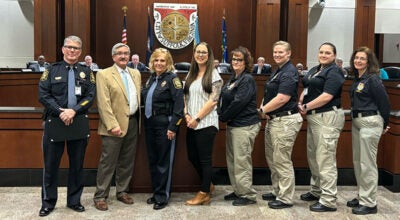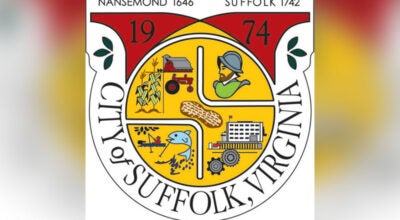NSA alumni call for changes at school
Published 10:14 pm Friday, June 19, 2020
|
Getting your Trinity Audio player ready...
|
Twenty seconds after entering Nansemond-Suffolk Academy for the first time as an eighth-grade student in 1994, Warren Carroll knew something was not right. It is a feeling that has stayed with him for more than 25 years.
“It wasn’t a surface feeling, like, ‘Oh, I’m different,’” said Carroll, a 1999 NSA graduate. “It was like me taking a step in a deep history. I felt that. I felt like quicksand almost. It was a lot deeper than, ‘He’s black and I’m white.’ It was a lot like historical pre-judgment.”
Carroll hopes sharing his experiences as the first Black student to attend the school for the entirety of its upper-school program — grades 8 through 12 — will help prompt change at NSA, which began as a segregationist school in 1966.
When Nansemond-Suffolk Academy opened more than 50 years ago, it was a place where white parents could send their children to school and avoid having them integrated into the public schools in the city — but you won’t find anything about that on its website.
Private segregationist schools began opening in Southern states after the U.S. Supreme Court ruled in Brown v. Board of Education in 1954 that segregated public schools were unconstitutional. It ruled in 1976 that federal law prohibited private schools from discriminating on the basis of race also.
Getting the school to acknowledge its history and institute other changes is the purpose behind the group, Anti-Racist Saints, which formed earlier this month following the death of a Minneapolis, Minnesota man, George Floyd, after a white police officer put a knee on his neck and pressed it there for nearly nine minutes.
Floyd’s death, along with the deaths of Ahmaud Arbery, Breonna Taylor and Tony McDade, all of whom are Black, have sparked protests around the country, including Suffolk, and have called attention to racial injustices.
“We urge our alma mater to use this moment to recognize its own contribution to injustice and to take steps towards becoming an anti-racist institution,” the Anti-Racist Saints group said in a letter to NSA head of school Deborah Russell and its Board of Trustees.
Within the first three days after the letter went public June 12, more than 500 alumni and 150 community members — among them current and former students, parents of alumni, current and past members of the school’s board of trustees, and faculty members — had signed the letter.
“The sordid origins of the Academy are tightly threaded into the cultural fabric of NSA, creating an isolating and hostile environment for Black and brown students,” the letter states. “Given shifts in legal and moral responsibilities since its founding, NSA no longer overtly discriminates based on race, yet the Academy continues to utilize prejudicial bias and pedagogical techniques that are anti-Black.”
The letter goes on to state, “NSA has an obligation to publicly acknowledge its segregationist history and to actively correct the damages it has caused to Black and brown communities.”
Russell issued a statement, posted on the school’s website, that stated its commitment to equity and inclusion.
“…While we cannot ignore our history or mistakes we have made in the past, it is important that we look forward together,” Russell wrote June 3. “At NSA, we resolve to further our commitment to improve our school, our community and our world through further education and action so every individual, regardless of the color of their skin or differences, feels safe, respected, valued and connected to those around them.”
Russell wrote that it important for the school to “open the dialogue, have conversations and listen in order to move forward in a positive manner for justice and human dignity for all.”
In another message June 9 to the school’s alumni, she invited alumni to virtual meetings of its Equity and Inclusion Committee last Monday.
Winford K. Rice Jr., who graduated from NSA in 2010 and went there starting in pre-K, said the group was expecting to hear from the school by the end of this week to respond to the letter, but as of 4:30 p.m. Friday, had not heard from Russell or the school.
The letter by Anti-Racist Saints said it recognizes Russell’s statement about how the school is committed to equity and inclusion. However, the group said the school has not explained how it planned to make structural changes and called for the school to take the following actions:
- Publicly acknowledge NSA’s founding history as a “white flight” academy following Brown v. Board of Education
- Revise NSA’s mission statement to include values on diversity, equity and inclusion
- Establish support networks for Black and brown students and staff
- Admit more Black and brown students and provide more scholarship opportunities for them
- Hire and retain more Black and brown faculty and staff
- Provide anti-racism, bias and cultural competency training
- Implement an anti-colonial, anti-racist curriculum across all grade levels
- Expand the Honor Code to condemn bigotry and prejudice
- Make sustained financial contributions to the local Black and brown community
- Establish a Black scholarship fund and develop lasting partnerships with historically Black colleges and universities.
“While NSA cannot change its history, it can change its legacy,” the Anti-Racist Saints letter states. “This is the beginning of what should be an ongoing conversation with alumni and the community to determine how these steps can best be implemented.”
In a statement to the News-Herald Friday, Russell said the school “appreciates the detailed and heartfelt letter,” and said NSA is taking a fresh look at its mission and practices, “acknowledging what it has done right and what it could do better in terms of racial relations.” She said the school has the goal of creating an environment where all students feel valued, appreciated and challenged.
“The letter raised many issues and our administration, faculty and trustees are carefully reviewing all of them,” Russell said. “We intend to enlist the assistance of outside experts to recommend a process that will lead to meaningful dialogue and engagement, and trust that those who signed the letter will participate, as the school will, in good faith.”
In the past 10 years, the school stated, it has nearly doubled its students of color, who make up 23 percent of the school population, while 24 percent of the class of 2020 are students of color. The data provided by the school did not indicate, specifically, the percentages of Black or brown students. Black or brown faculty has increased from 2 to 8 percent, and of all the school’s employees, nine percent are people of color.
The school also noted that in 2010, 7 percent of its Board of Trustees were Black or brown, but now, that is up to 17 percent, or four trustees. A statement from the school Friday noted that students of color who have graduated from NSA have gone on to earn undergraduate and graduate degrees at prestigious colleges and universities in Virginia and out-of-state, and have had successful careers in a variety of professions.
Ashney Vann, who started NSA in seventh grade and graduated in 2007, describes being at the school as a culture shock because she had come from a multiracial public school in Portsmouth to a school that was nearly all-white. She recalled being one of just three Black students at the school when she started.
“I don’t think I was ever terrified,” said Vann, 31, who lives in Portsmouth and works there as a special education teacher. “I don’t ever remember anything where I was just called a name, or outright, anybody being disrespectful or rude. But it was a lot of singling out or looking for things to be blamed for.”
Vann said her parents prepared her to be in the school’s environment.
“My mom was very protective of me not becoming a stereotype at the school,” Vann said, “and I was always afraid of becoming the Black girl, or the Black girl that did this, or the Black girl that did that.”
She remembered on about 10 occasions the curls in her hair being pulled by another student but never thought anything of it, but looking back on it, she said the person who did it didn’t know it was offensive.
“I don’t think it was intentionally offensive,” Vann said. “Hair was one of the things that separated us. … I felt like I was always being taken apart about the things that I didn’t do as a Black person that you do as a white person on a regular basis.”
Vann appreciated NSA’s academic rigor, which she said prepared her well in that way for her time at Norfolk State University, but it did not prepare her socially, and she “had to find myself again as a black person.”
Besides the steps outlined in the Anti-Racist Saints letter, she wants something else from the school.
“NSA has to do a better job of showing a little more understanding of the demographics that they have at that school, Black and brown,” Vann said. “I do think they need to have more representation of Black and brown in more roles at that school.”
Rice, 28, a professor of religion, philosophy and social ethics at Morehouse College in Atlanta, said he isn’t sure if NSA has the leadership in place to deal with the complexities of race, and said he does not pride himself on being a graduate of the school.
He felt like there were gaps in his education, particularly in areas of American history and literature, that things were taught too much from a Euro-centric point of view. He recalled a Colonial Craft Day in fourth grade in which students had to dress in colonial clothing and said it was “psychologically damaging” for Black and brown people to have to replicate a period in time in which they were not free.
“If the mission of the Academy is to educate people,” Rice said, “I often think about the quote from (Dr. Martin Luther King Jr.) that education is not just intelligence. Education is intelligence plus character. And if you have individuals in these places who are perpetuating classic narratives of blackness, or if its base functions are that what James Baldwin called Negro-phobic, it’s not a safe place for all of its students.”
He said just two of the 76 students in his graduating class were Black, and he did not have a Black teacher.
“That’s a shame that you can go through NSA and never have a Black teacher as a Black student,” Rice said. “That is, in many ways, morally and pedagogically reprehensible.”
Carroll had ties to the school before he began going there in 1995. His mother had done janitorial work at the school — she still works there — and he hung out with her, forming close friendships with several elementary school students.
They invited him to attend the school, and later that summer, Carroll learned the school was willing to admit him, but he had just one day to make the choice to attend.
So he made the choice to leave John F. Kennedy Middle School to go to NSA. It was a decision that would make him feel ostracized both at school and in his Lake Kennedy neighborhood. They had expected him, as an athlete who had done well and developed a reputation in the city, to continue at John F. Kennedy and then star at Nansemond River High School.
“Once I started going to NSA, it’s like the city looked at me different,” Carroll said. “Everywhere I went in my neighborhood — I’m from the inner city — and around there, it was ‘traitor this, traitor that.’ So not only did I have to deal with the pressure at school, but when I got home, I couldn’t win either way. But at that time, I was already locked in.”
Though Carroll chose to go to NSA because of the friends he already had that were going to the school, his athletic prowess, he said, soon became apparent, and he became pigeon-holed. He wanted to be seen as a student and a classmate, and not as just an athlete.
But with his friends, and English and math teachers who supported him, Carroll graduated from NSA and went on to major in philosophy at Ferrum College, gravitating out of athletics.
Now 39 and living in Richmond with a wife and son, Carroll said after he shared his story on the Anti-Racist Saints Facebook page, he got calls, texts and other messages apologizing to him. He asked where the apologies were 20 years ago, when he could feel the school’s segregationist past, heard the N-word on a regular basis, attended “tone-deaf cultural assemblies” and, outside of the small circle of friends and a pair of teachers, did not feel supported or valued. It was the first instance, he said, “of me suppressing my feelings in lieu to being a part of this prejudice culture.”
He said students were not allowed to talk to him on the phone because he was black, or for the same reason, was not allowed to go to their house, date or take a girl to prom.
“The words, ‘I can’t go with you to the dance or prom because you’re black,’” Carroll wrote, “still plays in my head till this day.”
He said people have approached his mother and asked why he is speaking out, now, about the school. Carroll stressed that he is not attacking anyone at the school but just wants to see the school change to become more inclusive for the benefit of all students and all staff, of all races.
“You’re trying to say that you do want to change,” Carroll said, addressing NSA directly. “I want you to take a stand with me, take a stand and say that, you know what, this is what our school was raised up on, this is what our school was built off of, but we no longer stand for that. I want those kind of words to come out. I want them to publicly say these things, and publicly mean these things, and publicly tell people what they’re going to do. I want them to feel accountable.”






